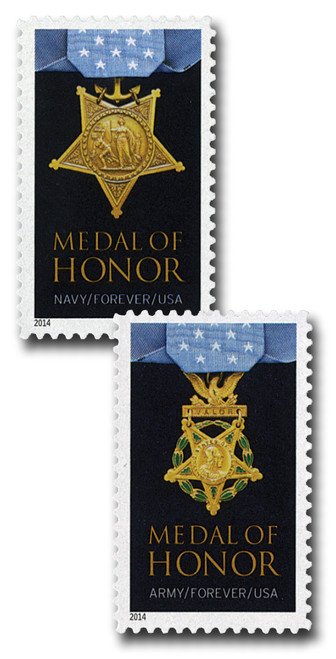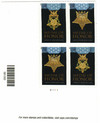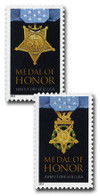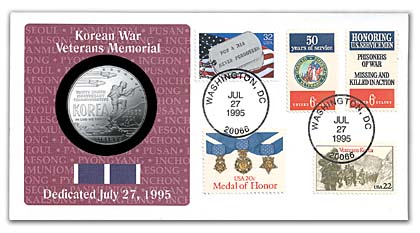
# 4822a-23a - 2014 First-Class Forever Stamp - The Medal of Honor: Korean War
U.S. # 4822a-23a
2014 47¢ Medal of Honor: Korean War
One hundred forty-six Medals of Honor have been awarded to servicemen for their gallant actions in Korea between 1950 and 1953. Of these, the majority fought in the Marines or the Army. Four servicemen honored were in the Air Force.
The Congressional Award was introduced in December 1861 for Navy officers, seamen, landsmen, and marines who “distinguish[ed] themselves by their gallantry.” An Army medal followed soon after in February 1862. The advent of flight in the 20th century led to the Army Air Corps, but the 46 airmen earning the Medal of Honor in WWI, WWII, and Korea were all recognized with Army medals.
It was not until long after the creation of the U.S. Air Force in 1947 that a separate and distinct medal was contemplated to recognize airmen. In 1956, a new medal was authorized and in 1965 its design was approved. Since 1965, 14 airmen have received the distinction.
Sadly, the majority of Medals of Honor are bestowed posthumously. Though gone, these war heroes are not – and will never be – forgotten. Today, the names of all Medal of Honor recipients from the Korean War and all other military conflicts are memorialized at the Congressional Medal of Honor Museum in Mt. Pleasant, South Carolina.
Following the format of the 2013 World War II Medal of Honor issue, the 2014 stamps honor the 145 recipients of the award from the Korean War. Photos of the last 13 living recipients were pictured on the front of the prestige folio, a new stamp format, with the names of all those rewarded printed in the back. The stamps picture the Army and Navy versions of the Medal of Honor, photographed by Richard Frasier.
Korean Armistice Agreement Signed
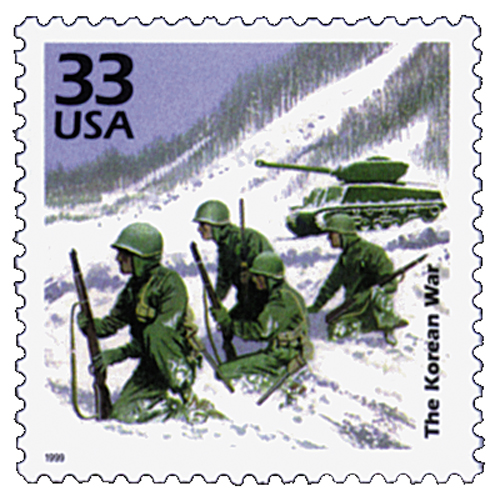
On July 27, 1953, the Korean Armistice Agreement was signed, bringing about the end of fighting in the Korean War.
The war had begun on June 25, 1950, when North Korea invaded South Korea. The US and the UN quickly joined in to support South Korea and eventually the Chinese would join the north.
The US had hoped to start peace talks to bring an end to the war. The US asked the UN to establish a military armistice commission to oversee all agreements. US officials proposed the creation of a 20-mile wide demilitarized zone, the cessation of hostilities, and the one-for-one exchange of prisoners of war.
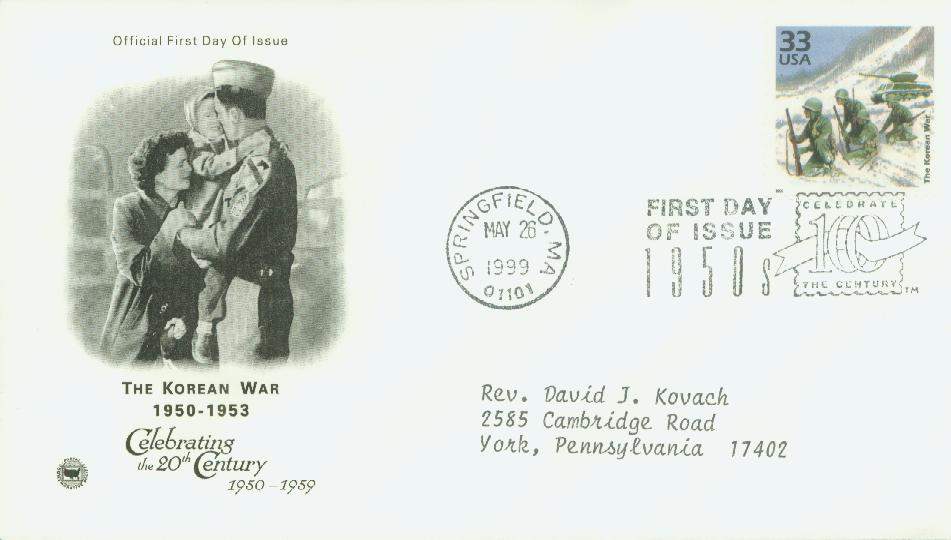
One issue with this was that South Korea’s President Syngman Rhee opposed the peace talks. He wanted his army to march up the Yalu Rive and unite the Koreas. While the UN didn’t support Rhee’s plan, his government did and they passed a resolution that supported the fighting for an “independent and unified country.” However, his government quickly changed course and supported the peace talks, though Rhee continued to oppose them.

In North Korea, leader Kim Il-sung also wanted to unite the country. Initially, he and his government had the slogan “drive the enemy into the sea.” But by the time the first armistice talks were held the following year, they changed their slogan to “drive the enemy to the 38th parallel.”

The first armistice talks were held on July 10, 1951, in Kaesong, North Korea, close to the border with South Korea. The talks would move very slowly after that. In August, North Korea claimed that the conference site had been bombed and ordered an investigation. The talks didn’t resume until October. The US also requested that the talks be moved to Panmunjom, closer to the border.
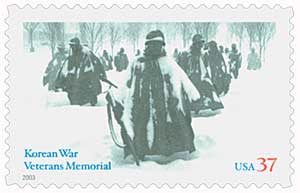
One of the biggest issues of the talks was prisoners of war. The Communists had 10,000 POWs and the UN had 150,000. They struggled to agree on terms because many North Korean soldiers didn’t want to return to the North, which North Korea found unacceptable. The Neutral Nations Repatriation Commission would later settle the issue. Another issue of contention was the location of the demilitarized zone.
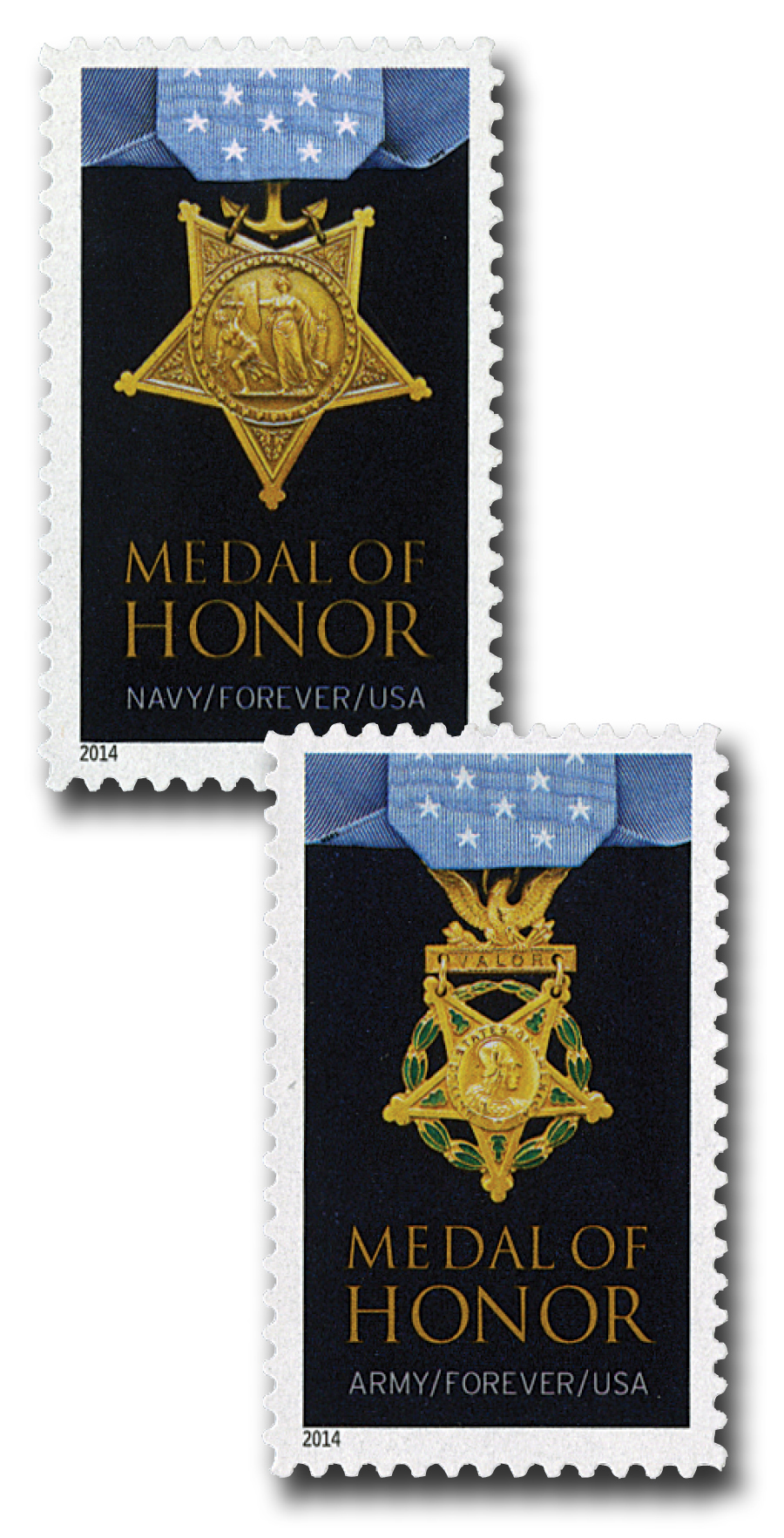
By July 19, 1953, all of the delegates finally reached an agreement on all of the issues for the armistice. At 10 a.m. on July 27, delegates from the UN, North Korea, and China signed the document agreeing to cease the fighting. South Korea’s president didn’t sign the armistice because he refused to accept Korea’s division, but he did agree to cease fighting. The exchange of prisoners followed after about 60 days and those who didn’t want to return to their home countries weren’t forced to.
U.S. # 4822a-23a
2014 47¢ Medal of Honor: Korean War
One hundred forty-six Medals of Honor have been awarded to servicemen for their gallant actions in Korea between 1950 and 1953. Of these, the majority fought in the Marines or the Army. Four servicemen honored were in the Air Force.
The Congressional Award was introduced in December 1861 for Navy officers, seamen, landsmen, and marines who “distinguish[ed] themselves by their gallantry.” An Army medal followed soon after in February 1862. The advent of flight in the 20th century led to the Army Air Corps, but the 46 airmen earning the Medal of Honor in WWI, WWII, and Korea were all recognized with Army medals.
It was not until long after the creation of the U.S. Air Force in 1947 that a separate and distinct medal was contemplated to recognize airmen. In 1956, a new medal was authorized and in 1965 its design was approved. Since 1965, 14 airmen have received the distinction.
Sadly, the majority of Medals of Honor are bestowed posthumously. Though gone, these war heroes are not – and will never be – forgotten. Today, the names of all Medal of Honor recipients from the Korean War and all other military conflicts are memorialized at the Congressional Medal of Honor Museum in Mt. Pleasant, South Carolina.
Following the format of the 2013 World War II Medal of Honor issue, the 2014 stamps honor the 145 recipients of the award from the Korean War. Photos of the last 13 living recipients were pictured on the front of the prestige folio, a new stamp format, with the names of all those rewarded printed in the back. The stamps picture the Army and Navy versions of the Medal of Honor, photographed by Richard Frasier.
Korean Armistice Agreement Signed

On July 27, 1953, the Korean Armistice Agreement was signed, bringing about the end of fighting in the Korean War.
The war had begun on June 25, 1950, when North Korea invaded South Korea. The US and the UN quickly joined in to support South Korea and eventually the Chinese would join the north.
The US had hoped to start peace talks to bring an end to the war. The US asked the UN to establish a military armistice commission to oversee all agreements. US officials proposed the creation of a 20-mile wide demilitarized zone, the cessation of hostilities, and the one-for-one exchange of prisoners of war.

One issue with this was that South Korea’s President Syngman Rhee opposed the peace talks. He wanted his army to march up the Yalu Rive and unite the Koreas. While the UN didn’t support Rhee’s plan, his government did and they passed a resolution that supported the fighting for an “independent and unified country.” However, his government quickly changed course and supported the peace talks, though Rhee continued to oppose them.

In North Korea, leader Kim Il-sung also wanted to unite the country. Initially, he and his government had the slogan “drive the enemy into the sea.” But by the time the first armistice talks were held the following year, they changed their slogan to “drive the enemy to the 38th parallel.”

The first armistice talks were held on July 10, 1951, in Kaesong, North Korea, close to the border with South Korea. The talks would move very slowly after that. In August, North Korea claimed that the conference site had been bombed and ordered an investigation. The talks didn’t resume until October. The US also requested that the talks be moved to Panmunjom, closer to the border.

One of the biggest issues of the talks was prisoners of war. The Communists had 10,000 POWs and the UN had 150,000. They struggled to agree on terms because many North Korean soldiers didn’t want to return to the North, which North Korea found unacceptable. The Neutral Nations Repatriation Commission would later settle the issue. Another issue of contention was the location of the demilitarized zone.

By July 19, 1953, all of the delegates finally reached an agreement on all of the issues for the armistice. At 10 a.m. on July 27, delegates from the UN, North Korea, and China signed the document agreeing to cease the fighting. South Korea’s president didn’t sign the armistice because he refused to accept Korea’s division, but he did agree to cease fighting. The exchange of prisoners followed after about 60 days and those who didn’t want to return to their home countries weren’t forced to.

